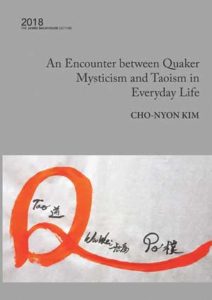An Encounter between Quaker Mysticism and Taoism in Everyday Life
Reviewed by Bob Dixon-Kolar
February 1, 2019
 By Cho-Nyon Kim. James Backhouse Lectures, 2018. 38 pages. $14/pamphlet; $8/eBook.
By Cho-Nyon Kim. James Backhouse Lectures, 2018. 38 pages. $14/pamphlet; $8/eBook.
The slender, intriguing pamphlet An Encounter between Quaker Mysticism and Taoism in Everyday Life is an expanded version of Cho-Nyon Kim’s James Backhouse Lecture, presented at the 2018 gathering of Australia Yearly Meeting in New South Wales. In his lecture, Kim, a professor of sociology and a member of Daejeon Meeting in South Korea, discusses how his Christian faith—particularly his decision to become a Quaker—arose within a Korean religious milieu that blended Confucian, Buddhist, Taoist, and local folkways and beliefs. His religious faith was also strongly influenced by the late Korean Quaker Ham Sok-Hon, a courageous advocate for peace and justice. Like Ham before him, Kim is a universalist Quaker, who is, in his own words, “freed from the idea that Christianity is the only religion and that the Bible alone proclaims complete truth.” In Quakerism, Kim found ideals toward which he was “deeply attracted”: “peace, simplicity, equality, community, truth, sustainability and integrity,” and he seeks to live out these Quaker ideals in his everyday life.
An overriding theme of Kim’s lecture is that religions, like all things in the universe, change with time. Indeed, if a religion is to survive, it must change to meet the needs of each new era. Quakerism is no exception. Kim says, “I think it would be meaningful to look into Taoism for the purpose of expanding the religiosity of Quakerism.”
Taoism and Quakerism, each in their way, affirm the importance of simplicity, nonviolence, and pacifism. And both have a mystical foundation, which can give anyone access to an “an inner light . . . an inner teacher . . . [A]ll can find a way to Buddha-nature and get in touch with Tao.” Interestingly, the mysticism that Kim speaks of is not esoteric. “This is the mystical experience of everyday life,” he says. “Mysticism is a very normal life.”
Nevertheless, Kim admits his “grave doubts” about his ability to live a pure and loving life in a world that is often anything but pure and loving. How does one practice a simple lifestyle within a society that has become insanely complex? He wonders how one acts peacefully among people who know only striving and competition? How does one show respect for our natural ecosystem when, as Kim puts it, “birth itself is an environmental destruction”? There is a self-searching humility to Kim’s reflections, and many a Friend who shares his doubts will be tempted to cry out, “Amen to that!”
As for Kim’s exposition of Taoist principles, I imagine that some readers will find his explanations obscure, even unsettling. He writes:
Tao does not work by human power but proceeds in its own way and time. This means that we should not regulate or direct life by civilisation and institution. “Doing nothing” is the pursuit of a life that renounces morality, law and form. An anarchistic life can be considered.
Do nothing? Renounce morality, law, and form? Consider an anarchistic life? These counterintuitive assertions beg for more elaboration. But, all in all, Kim is making a case for what he calls “positive passivity,” a sense of spiritual liberation and power that many Quakers experience when sitting in gathered silence with fellow Friends.
One happy consequence of reading this lecture would be for Friends to feel prompted to learn more about the remarkable Ham Sok-Hon, known as “the Gandhi of Korea.” American Friends Service Committee twice nominated Ham for the Nobel Peace Prize. A good place for Friends to start would be to read the remembrance of Ham in the September 1989 issue of Friends Journal after his death at age 87.



Comments on Friendsjournal.org may be used in the Forum of the print magazine and may be edited for length and clarity.